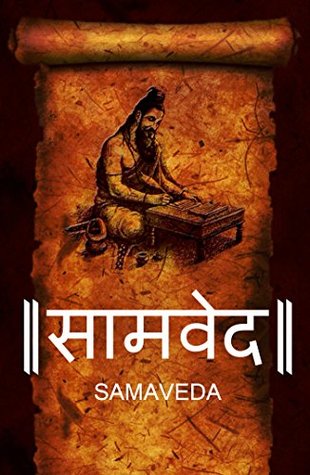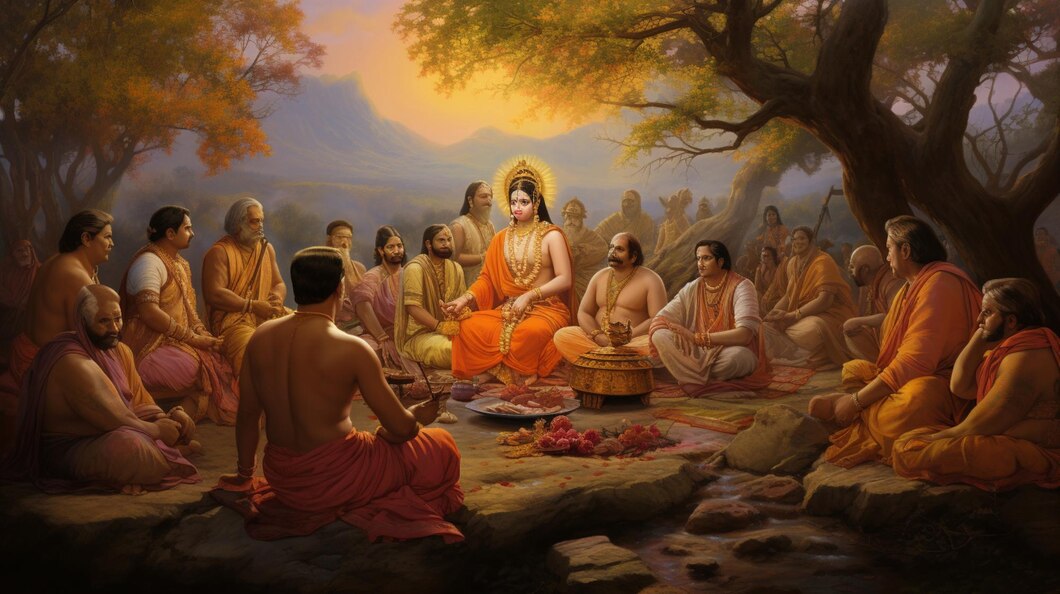Have you ever wondered how Sama Veda’s ancient chants can still resonate in our lives today? The Sama Veda is one of the four main texts of Hinduism and has a special place in Indian spirituality.
Compiled around 1200 BCE, it’s known as the “Veda of Melodies” because it takes hymns from the Rigveda and turns them into musical chants for rituals.
Its importance goes beyond just history; it has a big influence on today’s music and meditation practices. The Samveda highlights how sound and rhythm can connect us to the divine.
It is believed to be the foundation of Indian classical music, with its melodies and rhythms shaping the development of various musical traditions over centuries. The chanting of Sama Veda hymns is considered a form of meditation in itself, as the practitioner focuses on sound vibrations and their effects on the body and mind.
The Sama Veda focuses on the importance of sound and rhythm, which are thought to help us connect with the divine. In today’s world, its teachings are frequently used in music therapy and meditation, promoting mental wellness and spiritual growth.
Explore Sama Veda: The Ancient Chants That Still Resonate Today Through This Blog.
Join us in this journey where we explore the Sam Veda, which has timeless insights that still enhance our lives, blending ancient wisdom with modern practices.
Introduction to the Sama Veda
The Sama Veda is one of the four key texts in Hinduism, often called the “Veda of Melodies.” It originated around 1200 to 1000 BCE, during the time when Indo-Aryan tribes were settling in the Indian subcontinent.
These tribes brought along a wealth of cultural and spiritual traditions that helped shape the Vedic civilization. The Sama Veda mainly features hymns that adapt verses from the earlier Rigveda, turning them into musical chants meant for rituals.

With about 1,875 verses, many of these hymns highlight the significance of sound and melody in worship, reflecting the idea that music can link people to divine energies.
It’s more than just a collection of songs; it also contains explanations and philosophical texts, making it a well-rounded guide for spiritual practices. The Sama Veda has influenced Indian classical music and is still relevant in modern practices like meditation and yoga.
Read more about Rigveda – https://itihaaskikhoj.in/rigveda-exploring-the-invisible-world-of-wisdom/
History of Sama veda
The Sama Veda is pretty ancient, with its roots tracing back to about 1200 BCE, making it one of the oldest texts in Hindu tradition. It’s believed that it was compiled during the period when Indo-Aryan tribes migrated into the Indian subcontinent, introducing their unique cultural practices.
The Sama Veda is mostly based on the Rigveda, where a lot of verses got turned into melodies for rituals.
 Historically, people claim there were originally more than a thousand recensions (Shakhas) of the Sama Veda, but today, we only have three: Kauthuma, Jaiminiya, and Ranayaniya. Each of these versions comes with its own unique way and chanting style.
Historically, people claim there were originally more than a thousand recensions (Shakhas) of the Sama Veda, but today, we only have three: Kauthuma, Jaiminiya, and Ranayaniya. Each of these versions comes with its own unique way and chanting style.
The Kauthuma Shakha is particularly prominent and consists of two parts: Archika and Gana, which detail the procedures for chanting during rituals. The text’s historical context reflects a society deeply engaged in spiritual practices where music played a crucial role in rituals.
Plus, Sam Veda covers the idea of spiritual growth through music and points out that cleanliness and self-control are crucial for success. This rich history reveals how the Sam Veda has impacted both religious traditions and cultural expressions in music and spirituality over the centuries.
Check out the other blog – https://itihaaskikhoj.in/exploring-hinduism-the-worlds-oldest-religion/
Importance of the Sama Veda
Known as the “Veda of Melodies,” the Sam Veda holds a special place in the spiritual and cultural history of ancient India. Its standout feature is its focus on music and chanting, which sets it apart from the other three Vedas.
While the Rigveda is all about recited hymns, the Samveda takes those hymns and turns them into musical pieces meant for singing during rituals and ceremonies. This focus on melody not only enhances the spiritual experience but also highlights the idea that sound can connect people with the divine.
 The Sam Veda plays a key role in many Hindu rituals, especially those involving sacrifices, where its chants call upon blessings from gods like Agni and Indra. Plus, its teachings have been foundational for Indian classical music, shaping countless musicians and composers over the years.
The Sam Veda plays a key role in many Hindu rituals, especially those involving sacrifices, where its chants call upon blessings from gods like Agni and Indra. Plus, its teachings have been foundational for Indian classical music, shaping countless musicians and composers over the years.
An example of a chant from the Sama Veda is the invocation to Agni, the fire god, which emphasizes the importance of sound and melody in rituals. Here’s a well-known verse:
“Agni, come to the feast;
O Agni, with thy lofty beams,
With thy pure brilliancy, O God,
Kindled, most youthful one!”
This chant highlights how the Sam Veda transforms hymns from the Rigveda into songs that are performed during sacrifices and ceremonies. The repeated phrases and melodic patterns are crafted to invite Agni’s presence and blessings, showcasing Veda’s focus on the importance of sound in spiritual traditions.
The tunes from the Sam Veda are thought to have healing properties, boosting mental health and spiritual growth. So, the significance of the Sam Veda goes way beyond just rituals; it’s a crucial cultural treasure that still inspires and resonates in today’s spiritual practices.
Read more about Vedas: – https://itihaaskikhoj.in/4-vedas-the-pillars-of-indian-knowledge/
Purpose of the Sama Veda
The Sam Veda mainly serves as a guide for musical chanting in Hindu rituals and ceremonies. Unlike other Vedas that focus on philosophy or prose, this one highlights the importance of melody in worship.
Its verses are meant to be sung, which shows how important music is in connecting with the divine. You’ll find these chants used in major rituals like Soma sacrifices, where calling on gods like Agni, the fire god, is crucial for bringing blessings and prosperity.
Plus, the Sam Veda encourages devotion; by singing these hymns with genuine feeling, worshippers believe they can achieve spiritual growth and gain divine favor.
The Sam Veda also features a bunch of different chanting styles, which lets people express their devotion in unique ways that resonate with various communities and traditions throughout India. For example, there’s Grama-geya, which is all about singing together as a group, and then there’s Aranya, which highlights the beauty of meditating alone in nature.
 This highlights just how essential music is in Hindu spirituality, showing that sound has the power to go beyond everyday life and elevate people to a higher state of awareness.
This highlights just how essential music is in Hindu spirituality, showing that sound has the power to go beyond everyday life and elevate people to a higher state of awareness.
Read about the mantras and its power – https://itihaaskikhoj.in/mantra-power-mantras-for-spiritual-growth-and-clarity/
Modern-Day Use of the Sama Veda
In today’s society, the Sam Veda remains significant, especially in music therapy, meditation, and yoga. The melodic chants from this ancient text are often featured in modern meditation practices to help people relax and gain mental clarity.
Many practitioners believe these sacred sounds can create a peaceful atmosphere that encourages inner peace and spiritual growth. Music therapists also use concepts from the Sam Veda to leverage sound for emotional healing and stress relief.
By incorporating musical aspects from this age-old tradition, people can find greater mindfulness and emotional stability in their daily routines.
Additionally, educational institutions that focus on Indian classical music frequently draw on compositions from the Sam Veda as essential resources for learning about rhythm and melody in traditional music.
This means that the teachings of the Sam Veda continue to resonate with those searching for a balance between body, mind, and spirit.
Medical Science Insights from the Sama Veda
The Sama Veda is finding its way into modern healthcare, especially through its insights into sound therapy and its benefits for mental health. Research shows that certain sounds and rhythms can have a positive effect on brain activity and emotional well-being, concepts that are deeply rooted in the Sama Veda.
The chants associated with this Veda are thought to encourage relaxation when sung or listened to during meditation or yoga. Moreover, sound healing techniques inspired by these ancient chants are increasingly being acknowledged as effective complementary therapies for managing stress and anxiety in clinical settings.
Some practitioners even include Sama Veda chants in their holistic approaches, aiming to enhance overall health by addressing both physical and emotional challenges through sound vibrations. This connection between ancient teachings and modern health practices highlights the ongoing influence of the Sama Veda in today’s wellness landscape.
CONCLUSION
Exploring the Samveda is like uncovering rich layers of ancient wisdom that still speak to us today. Its hymns shed light on spiritual beliefs, ethical values, rituals, and philosophical questions that have influenced Indian culture for thousands of years. Being one of the oldest texts known to humanity, it connects us to the thoughts of our ancestors about life and morality, while also offering insights for modern living. The lasting impact of the Sam Veda encourages us to think about our role in the universe and inspires us to gain knowledge through self-reflection and tuning into nature’s rhythms

